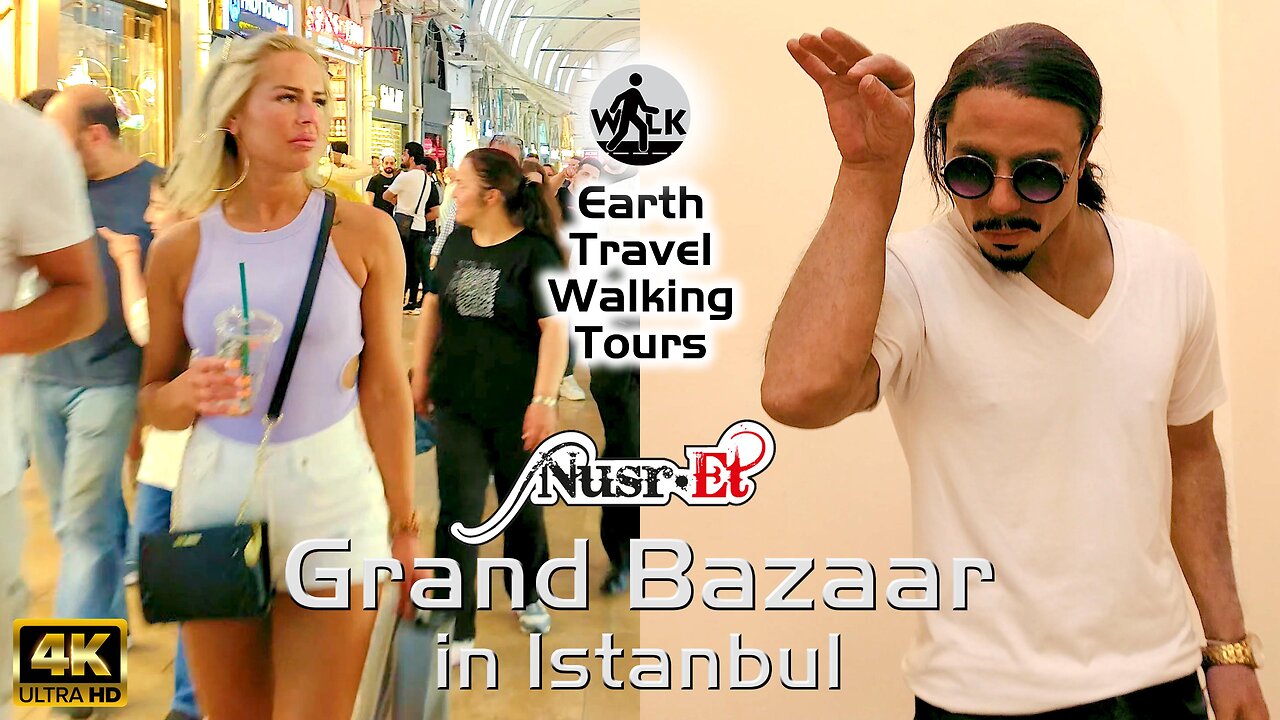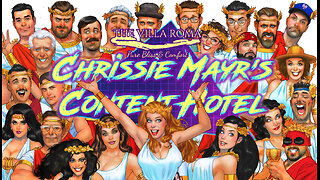Premium Only Content

Grand Bazaar (567 years old) - Walking Tour in Istanbul - 4K UHD
Walk with me 👉 https://bit.ly/3O7D0vg
My walk map 👉 https://bit.ly/39d4hxW
00:00 Intro and Summary
01:52 Grad Bazaar Walking
06:14 Small Bedesten / Sandal Bedesten (Nusret - Salt Bae)
08:59 Grand Bazaar Walking
21:35 Interesting wonderful products sold in the Grand Bazaar and walking
Grand Bazaar
The Grand Bazaar (Turkish: Kapalıçarşı, meaning ‘Covered Market’; also Büyük Çarşı, meaning ‘Grand Market’) in Istanbul is one of the largest and oldest covered markets in the world, with 61 covered streets and over 4,000 shops[2][3] on a total area of 30,700 m2, attracting between 250,000 and 400,000 visitors daily. In 2014, it was listed No.1 among the world's most-visited tourist attractions with 91,250,000 annual visitors. The Grand Bazaar at Istanbul is often regarded as one of the first shopping malls of the world.
History
The construction of the future Grand Bazaar's core started during the winter of 1455/56, shortly after the Ottoman conquest of Constantinople and was part of a broader initiative to stimulate economic prosperity in Istanbul. Sultan Mehmed II had an edifice erected devoted to the trading of textiles and jewels near his palace in Constantinople. It was named Cevâhir Bedestan ("Bedesten of Gems") and was also known as Bezzâzistan-ı Cedîd ("New Bedesten") in Ottoman Turkish. The word bedesten is adapted from the Persian word bezestan, derived from bez ("cloth"), and means "bazaar of the cloth sellers". The building – named alternately in Turkish İç ("Internal"), Antik ("Ancient"), or Eski ("Old") Bedesten – lies on the slope of the third hill of Istanbul, between the ancient Fora of Constantine and of Theodosius. It was also near the first sultan's palace, the Old Palace (Eski Saray), which was also in construction in those same years, and not far from the Artopoleia (in Greek) (Άρτοπωλεία), the city's bakers' quarter in Byzantine times.
In a market near the Bedesten, named in Turkish Esir Pazarı, the slave trade was active, a use also carried over from Byzantine times. Other important markets in the vicinity were the second-hand market (Turkish: Bit Pazarı), the "Long Market" (Uzun Çarşı), corresponding to the Greek Makros Embolos (Μακρός Ὲμβολος, "Long Portico"), a long porticoed mall stretching downhill from the Forum of Constantine to the Golden Horn, which was one of the main market areas of the city,[ while the old book market (Sahaflar Çarşısı) was moved from the Bazaar to the present picturesque location near the Beyazid Mosque only after the 1894 Istanbul earthquake.
Some years later —according to other sources, this occurred in 1545 under Sultan Suleiman I—Mehmed II had another covered market built, the "Sandal Bedesten" (the name comes from a kind of thread woven in Bursa, which had the colour of sandalwood[), also named Küçük ("Little"), Cedit or Yeni (both words meaning "New") Bedesten, which lay north of the first.[citation needed]
After the erection of the Sandal Bedesten the trade in textiles moved there, while the Cevahir Bedesten was reserved for the trade in luxury goods. At the beginning the two buildings were isolated.
At the beginning of the 17th century the Grand Bazaar had already achieved its final shape. The enormous extent of the Ottoman Empire in three continents, and the total control of road communications between Asia and Europe, rendered the Bazaar and the surrounding hans or caravanserais the hub of the Mediterranean trade. According to several European travelers, at that time, and until the first half of the 19th century, the market was unrivaled in Europe with regards to the abundance, variety and quality of the goods on sale. At that time we know from European travelers that the Grand Bazaar had a square plan, with two perpendicular main roads crossing in the middle and a third road running along the outer perimeter. In the Bazaar there were 67 roads (each bearing the name of the sellers of a particular good), several squares used for the daily prayers, 5 mosques, 7 fountains, 18 gates which were opened each day in the morning and closed in the evening (from these comes the modern name of the Market, "Closed Market" (Kapalıçarşı).[ Around 1638 the Turkish traveller Evliya Çelebi gave us the most important historical description of the Bazaar and of its customs. The number of shops amounted to 3,000, plus 300 located in the surrounding hans, large caravanserais with two or three stories round a porticoed inner courtyard, where goods could be stored and merchants could be lodged.
Social Media / Contact
Twitter : https://twitter.com/travelwalking
Instagram : https://www.instagram.com/earthtravelwalkingtours
Facebook : https://www.facebook.com/Earth-Travel-Walking-Tours-102888222457618
Web : http://www.earthtravelwalkingtours.com
E-mail : earthtravelwalkingtours@gmail.com
-
 1:20:15
1:20:15
vivafrei
2 hours agoRFK Jr. Takes on the Pharma WHOORES! Toddler-Assaulter Granted BAIL? COMPLYE WITH CRIMINALS! & more
76.6K24 -
 LIVE
LIVE
LadyDesireeMusic
1 hour ago $0.15 earnedLive Piano Request - Anti Brain Rot - Support Culture Shift
156 watching -
 LIVE
LIVE
The HotSeat
1 hour agoTrump’s Parade = Mocked, China’s Parade = Praised: Leftist Hypocrisy EXPOSED
648 watching -
 1:57:29
1:57:29
The Quartering
3 hours agoRFK Jr Goes NUCLEAR, Horrible Tomb Raider News, Anti-White Male Propaganda
84.1K17 -
 LIVE
LIVE
Dr Disrespect
5 hours ago🔴LIVE: Hell Is Us Launch - DR DISRESPECT’s First Look at the Scariest Game of 2025!
1,224 watching -
 LIVE
LIVE
Pop Culture Crisis
2 hours agoSabrina Carpenter Wants Feminist Approval, Demonic Rituals at Burning Man? | Ep. 910
321 watching -
 11:17
11:17
Dr. Nick Zyrowski
29 days agoTop 10 No CARB No SUGAR Foods That Will Change Your Health
22.3K4 -
 LIVE
LIVE
Chrissie Mayr
2 days agoChrissie Mayr's Content Hotel at The Villa Roma! Anthony Cumia, Dave Landau, Violet
66 watching -
![[Ep 741] RFK Jr. Hits Back at Rabid Dems | Portland Antifa Terrorists | The Evil That is the Left](https://1a-1791.com/video/fww1/bb/s8/1/W/U/c/f/WUcfz.0kob-small-Ep-741-RFK-Jr.-Hits-Back-at.jpg) LIVE
LIVE
The Nunn Report - w/ Dan Nunn
1 hour ago[Ep 741] RFK Jr. Hits Back at Rabid Dems | Portland Antifa Terrorists | The Evil That is the Left
173 watching -
 1:52:45
1:52:45
John Burk
3 hours agoThe Texas Hemp ban, DOJ removing guns from trans, and more.
13.7K3